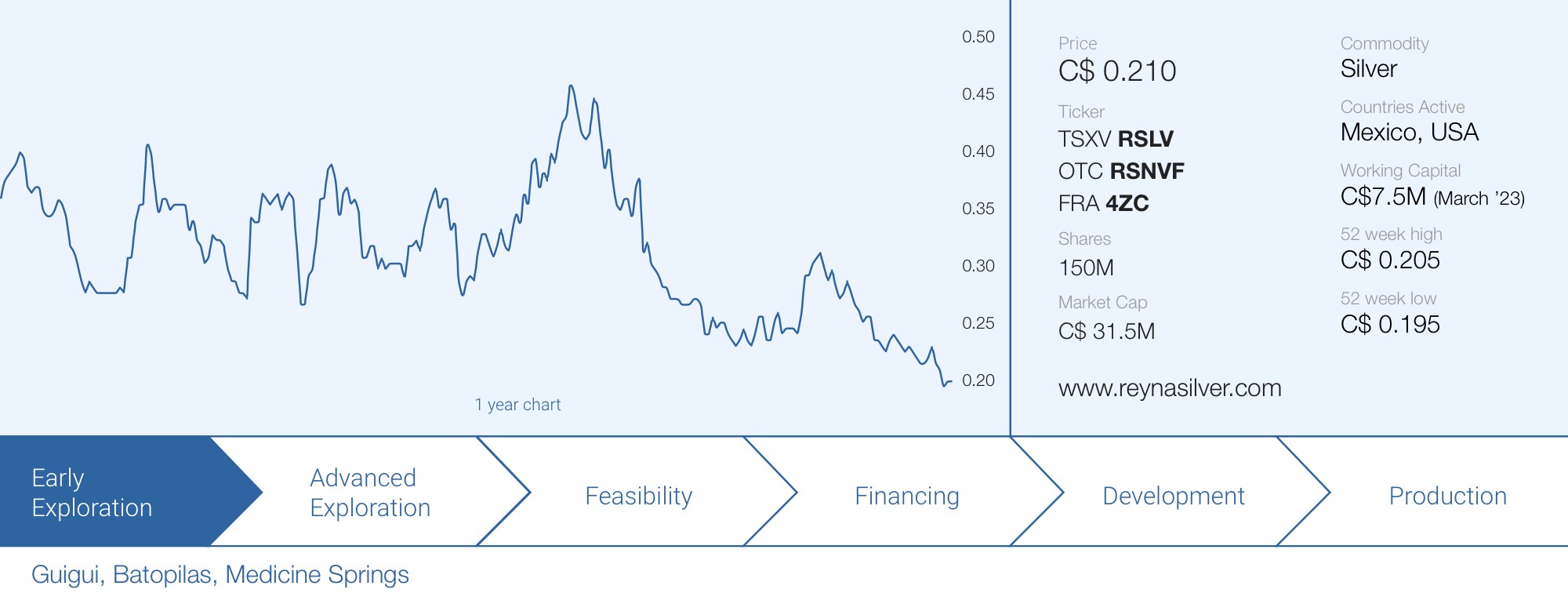
A few weeks ago, we flew to Chihuahua, Mexico to visit Reyna Silver’s (RSLV.V) Guigui project. Reyna Silver came out of the gate with the Guigui and Batopilas projects which it acquired from MAG Silver (MAG.TO, MAG) where the projects were just gathering dust on the shelf. Reyna didn’t just acquire the projects, it also signed up Peter Megaw as its Chief Technical Advisor to tap into his four decades of knowledge on the Santa Eulalia mining district in Mexico’s Chihuahua State.
Megaw is a Carbonate Replacement Deposit expert and obtained his Doctorate from the University of Arizona based on his extensive work on CRD-type deposits and deep dive into the Santa Eulalia district (so he breathes and lives CRD-type deposits). During his tenure at MAG Silver, he was instrumental in the discovery of both Juanicipio and Cinco de Mayo and together with his ‘partner in crime’ Rene Ramirez who played an instrumental role in the discovery of Excellon Resources’ (EXN.TO) La Platosa CRD mine, Megaw and Ramirez are now the driving forces of the Reyna Silver exploration team.
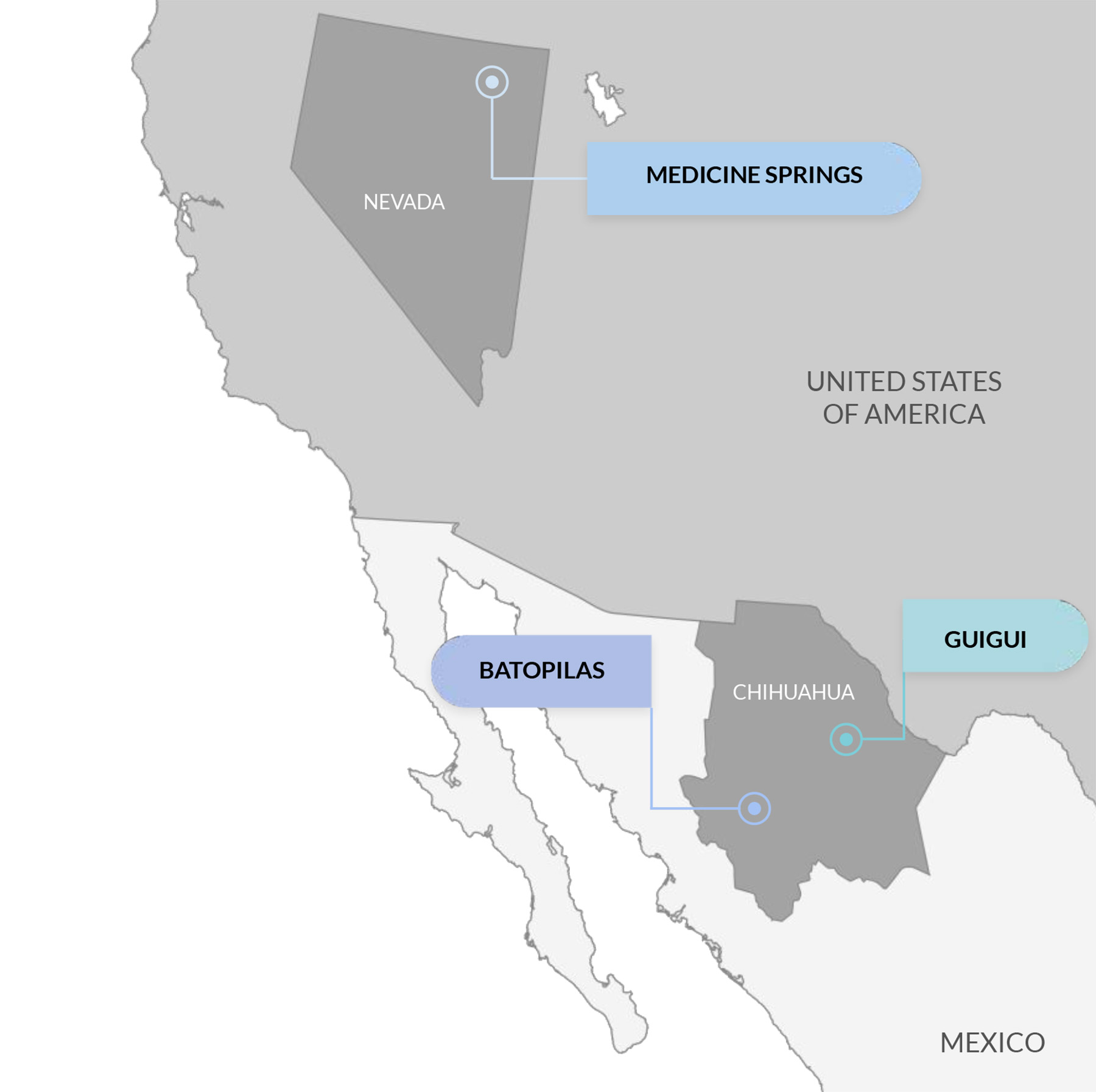
While Batopilas is a high-grade silver district with native silver, Guigui has all the characteristics of a CRD deposit. And as Reyna Silver entered into an agreement to acquire the Medicine Springs project in Nevada where it is also applying the CRD exploration theory, Reyna appears to be establishing itself as ‘the CRD company’. We should still consider all projects to be early stage exploration but as all three main projects will be drilled this year, Reyna Silver should be making a few more steps in the right direction.
Visiting the Guigui project in Chihuahua
Site visits are interesting as you can usually get a good understanding of the property, the local communities and the access to existing infrastructure. While a lot of companies and projects tout ‘excellent access to infrastructure’, we have rarely been more impressed with the actual location of a project than we were at Guigui.
The project is literally located about 15 kilometers east of Chihuahua, the capital of the Chihuahua province. It’s easy enough to get into Chihuahua as well as there are about half a dozen direct flights to Mexico City while American Airlines operates two flights per day (soon to be upscaled to three or four due to the increasing demand in the post-COVID era) from its Dallas-Fort Worth hub. Getting into Chihuahua is easy and you can reach the property within 30 minutes after leaving the airport premises. The Santa Eulalia district, where the project is located, is an area with some of the world’s most important Carbonate Replacement Deposits which historically produced about half a billion ounces of silver as well as sizeable amounts of lead and zinc as by-product credits. Gold and copper are also well-known elements in CRD systems with copper mainly occurring in the East Camp and not so much in the West Camp.








Site Visit at core shack
The total official production records for the district mention a total production of in excess of 500 million ounces of silver, almost in excess of 9 billion pounds of lead, about 8 billion pounds of zinc, 100 million pounds of copper and a few ten thousand ounces of gold from a total of approximately 51.5 million tonnes of rock (indicating an average recovered grade of 310 g/t silver and just over 15% ZnPb).
Reyna’s core shack is located on the outskirts of the city, just about ten minutes from the airport which makes it really easy for geologists to look at core and immediately have some sort of an idea of the location of the holes in the greater scheme of things.
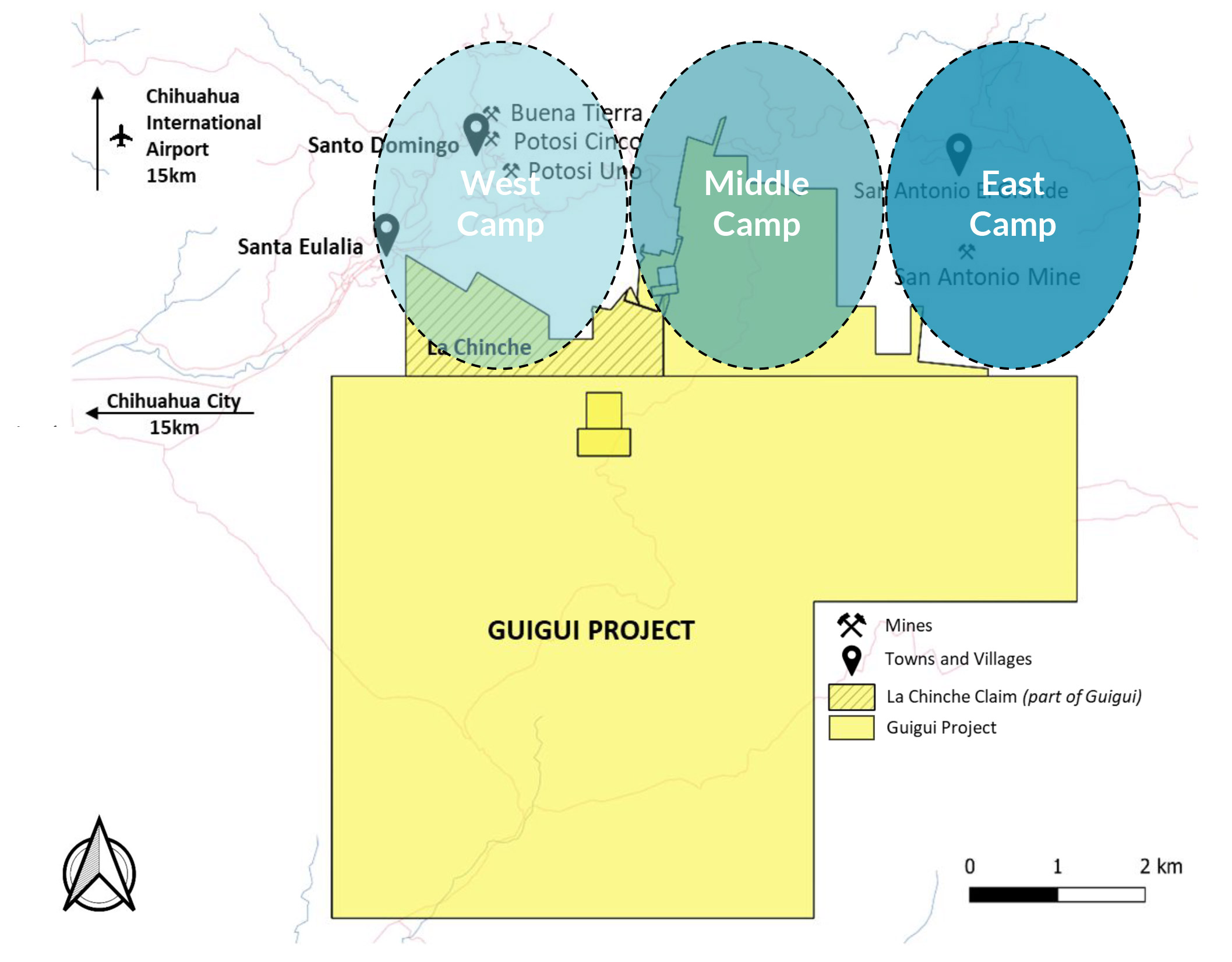
During the site visit, we also visited the so-called East Camp and the West Camp. The former is owned by Grupo Mexico and hosts the San Antonio mine which has been placed on care and maintenance. Initially due to COVID but a subsequent (controlled) flooding of the mine below level 8 has hindered the reopening efforts. Grupo Mexico might be on a crossroads here as it will have to make a decision on whether or not it makes sense to reopen the mine and access the zinc-rich layers below level 8. The existing mill has a capacity of 2,600 tonnes per day and in the event the San Antonio mine does not reopen after all, the existing facilities could be used for toll milling purposes down the road (but we are obviously still a very long way from any production here and Guigui should be seen as an early stage exploration story).











Site Visit at East Camp (Grupo Mexico, San Antonio Mine)
An exploration story in the right district though, as the region is well-known for its large carbonate replacement deposits and the table below sums up the best known CRD-type assets.
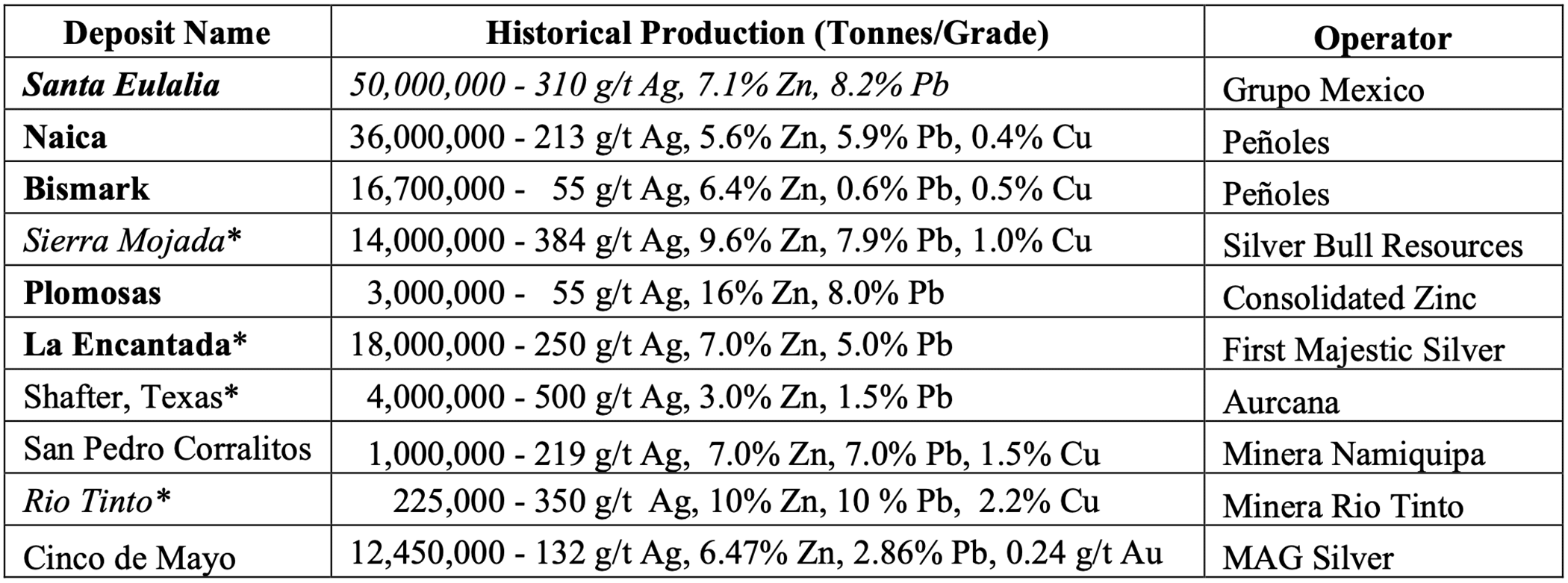
The reason why the West Camp and East Camp are so important for the exploration thesis at Guigui is because the starting premise is that those two mines are seen as the “chimney/manto” portion of a strongly mineralized system. According to the exploration theory of Peter Megaw (or perhaps Megaw & Megaw as daughter Lauren has been helping out to refine and adjust the CRD exploration model).
Perhaps we should take a step back here. Megaw has decades of experience studying, developing and refining an exploration model for Carbonate Replacement Deposits. These are potentially large and high-grade orebodies that cut across their host carbonate rocks and throughout the past three decades, Megaw has come up with and refined an exploration model with thirteen boxes to tick. The Guigui project ticks 12 of these boxes.
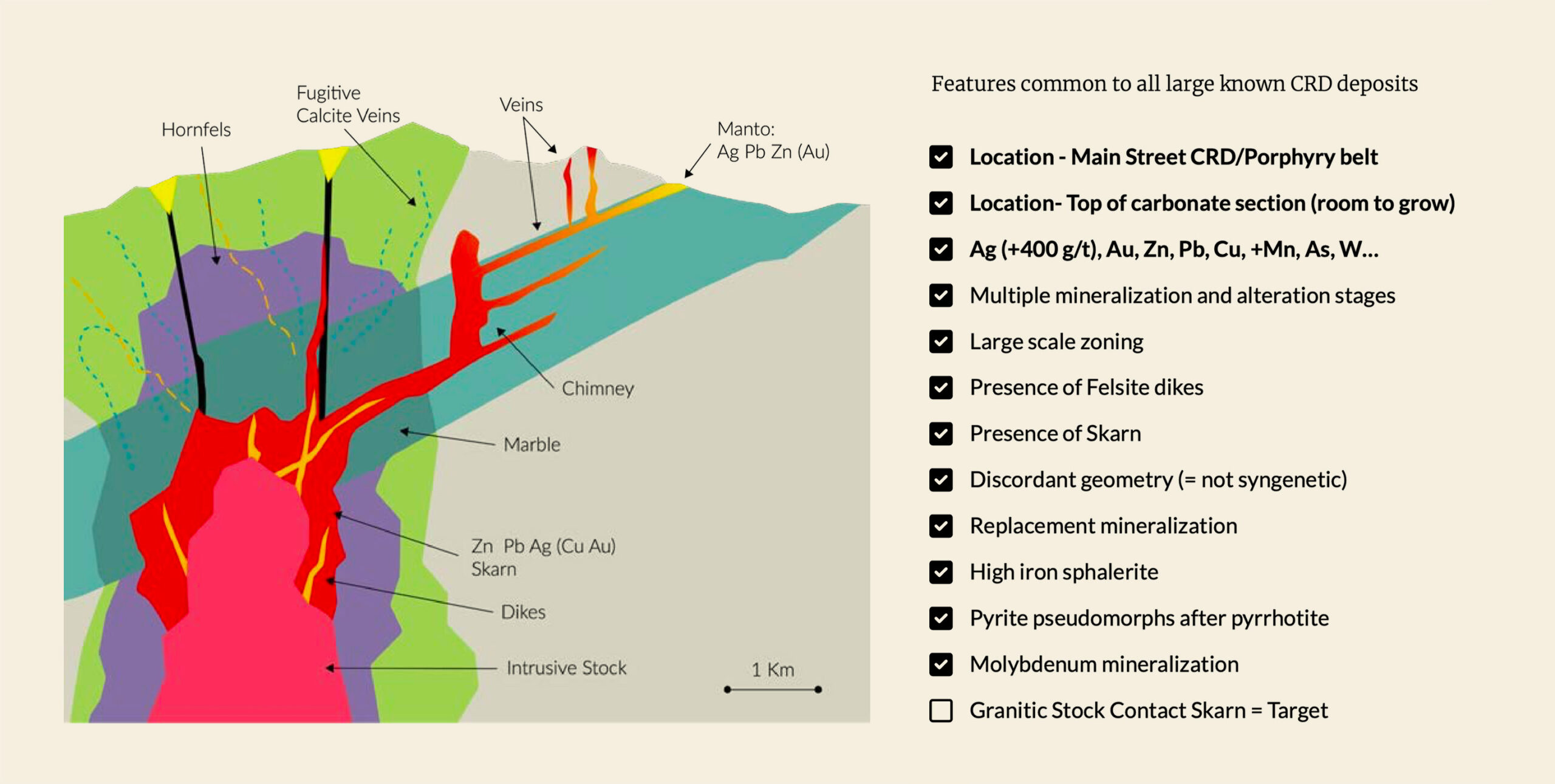
The exploration theory at Guigui is that it is a Carbonate Replacement Deposit where only two of the distal mineralized structures have been discovered and mined. The general consensus is that the source of the mineralization has not been discovered yet and according to Megaw the most likely location of that source is on the Guigui land package. Although there is no overlap between de-mineralized systems in the West and East Camps, they are believed to have resulted from the same evolution of hydrothermal systems. That’s what the drilling in the past few years has been focusing on, and that’s obviously also what will remain the main focus of the company at Guigui.
This is not a new exploration theory. Megaw initially published it as part of his 1990 PhD dissertation but unfortunately, the theory has never been thoroughly tested. Initial holes in the early nineties were either not drilled within the target area or didn’t reach the designed depth. In the late 90s Coralillo did obtain the permits for a 6-12 hole drill program but other projects were prioritized and the project ended up not being drilled at all. And even when MAG Silver owned the project it wasn’t easy for Guigui to shine. Right after making the Juanicipio discovery all exploration efforts and budgets were allocated to rapidly moving that discovery ahead which made a lot of economic sense.
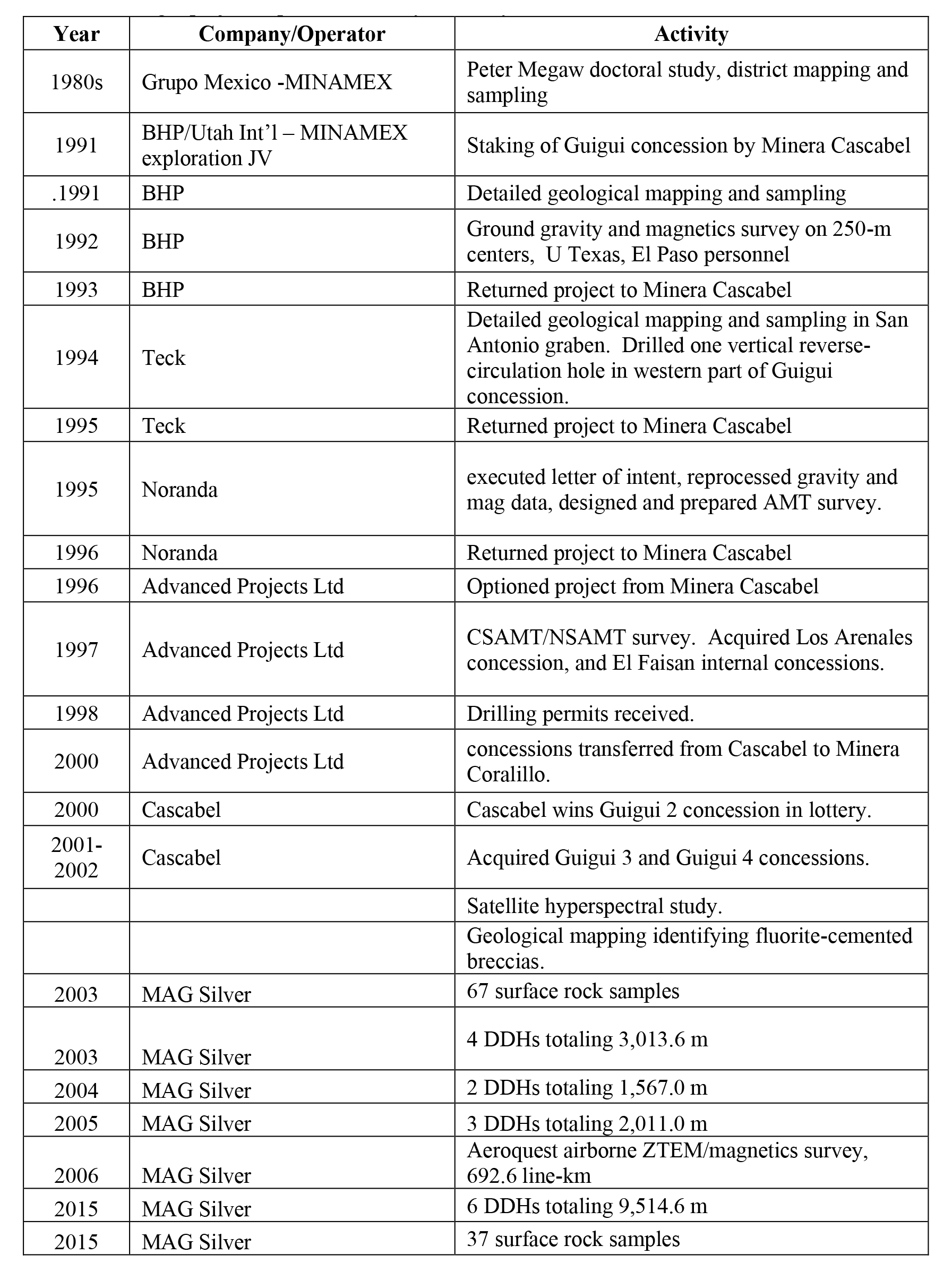
This however means that before Reyna Silver acquired the project in 2019, only a handful of holes were drilled, as you can see in the image above. Reyna has hit the ground running at Guigui and the company has completed about 20,000 meters of drilling in a two-phase drill program. Drilling was focused on the northern portion of the project, right in between the West and East Camp areas.
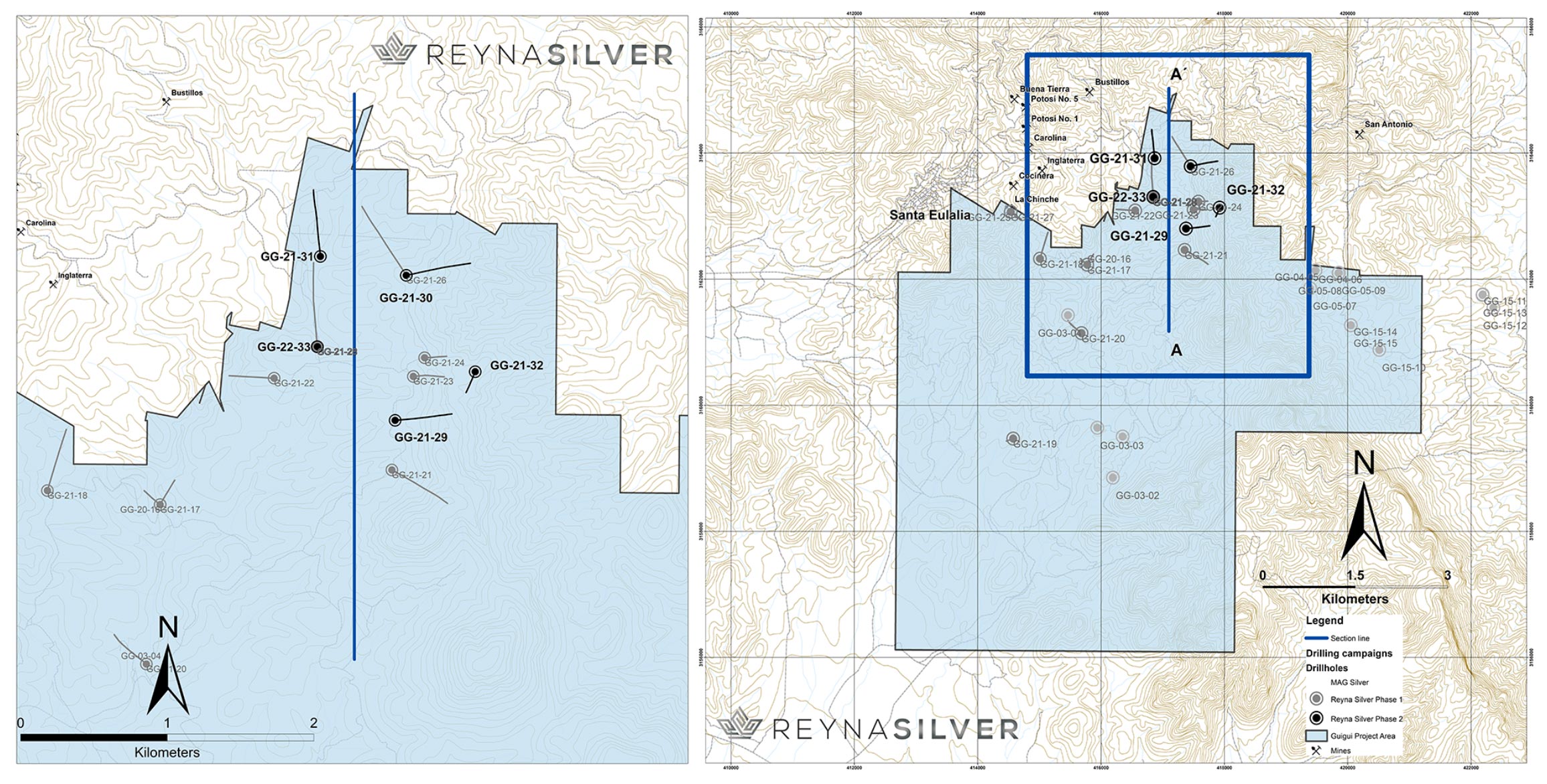
Those weren’t shallow holes. As you can see below, the average depth of the holes exceeded 1,000 meters with some holes extending for about 1,500 meters. And although drilling is cheap in Mexico, every hole still costs a few hundred thousand dollars.
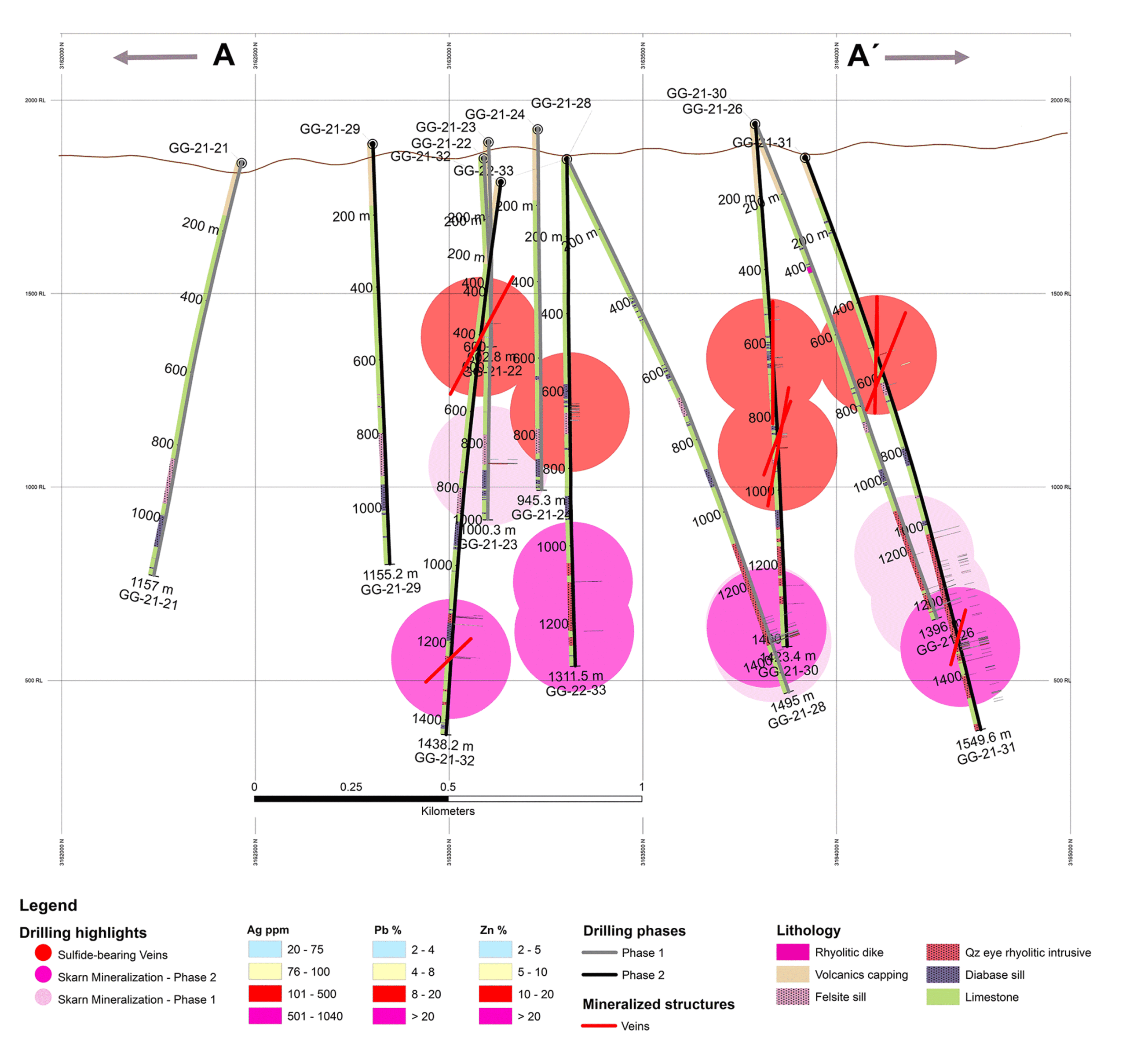
Some of the holes yielded results that were quite interesting (see below), but more drilling is needed to really find the hotspot of the mineralization. The traces are for sure there and this year’s drill program (details will likely follow later this year) will zoom in on the more prospective areas.
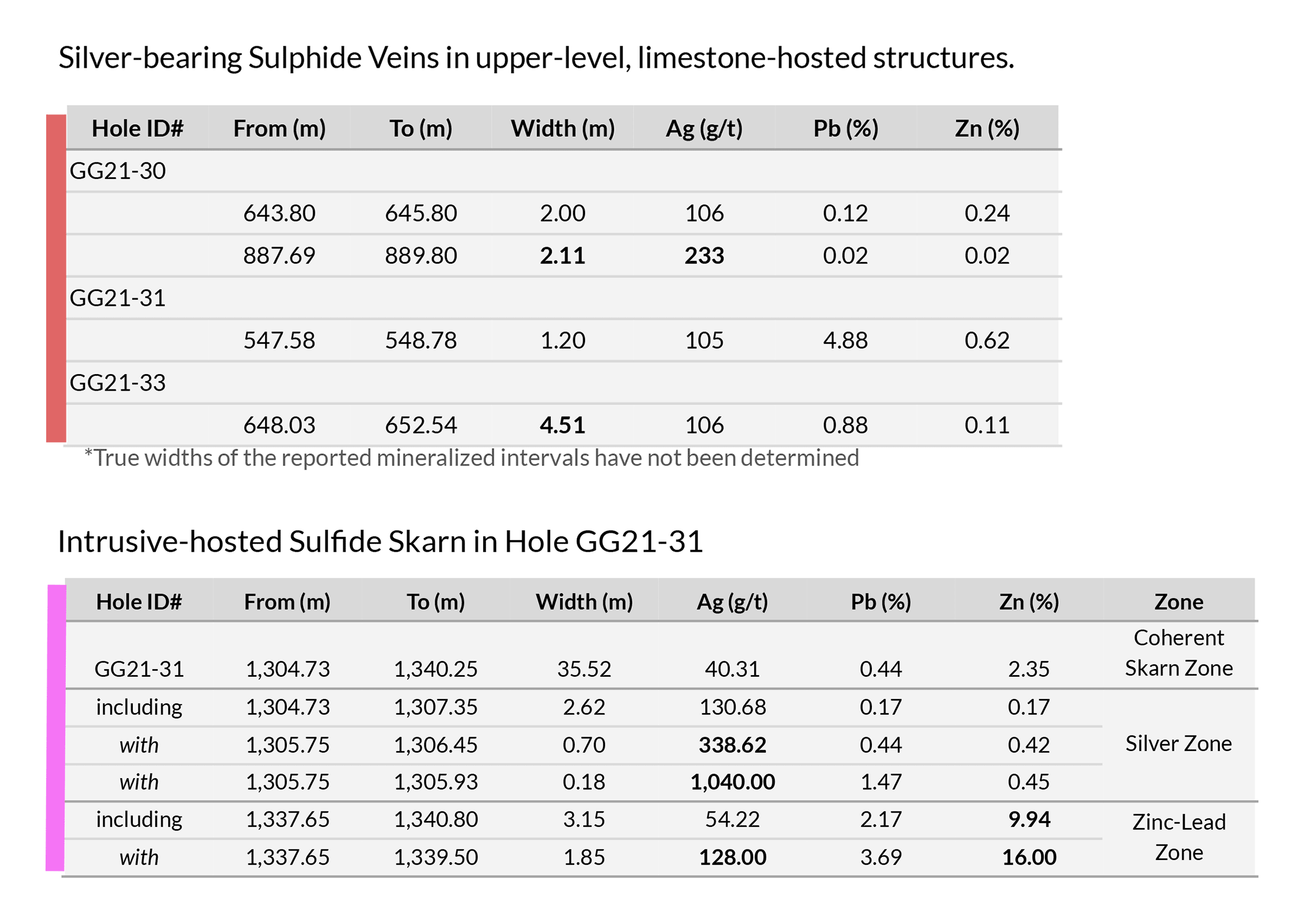








All three main projects will be drilled this year
During the site visit, it became clear the company wants to drill all three projects this year. Batopilas will be drilled first as Reyna Silver will want to follow up on the high-grade silver and gold discovery made in 2022. Batopilas has been a well-known high-grade silver district for hundreds of years but Reyna Silver also encountered high-grade gold during its 2021 drill program. That was surprising and the technical team needed some time to figure out what it meant and to design a follow-up drill program at Batopilas. The work program consisted of a very extensive sampling program consisting of taking almost 3,000 samples from old mine workings along underexplored structures and outcrops, which revealed additional gold mineralization to the southeast of the historic district.
We expect to see an announcement on the 2023 Batopilas drill program shortly as it is still combining all historical data. Drill results and the results of the sampling program will allow to further refine the interpretation of the mineralized system. In an interim update published earlier this month, Reyna Silver confirmed it is planning a 3,000 meter drill program, which is likely to start within the next few weeks.
Reyna Silver will also head back to the Medicine Springs project in Nevada, where it follows a similar methodological approach as it applies at Guigui to determine if Medicine Springs is a high-grade CRD system. The first-pass drill program in 2022 was encouraging.
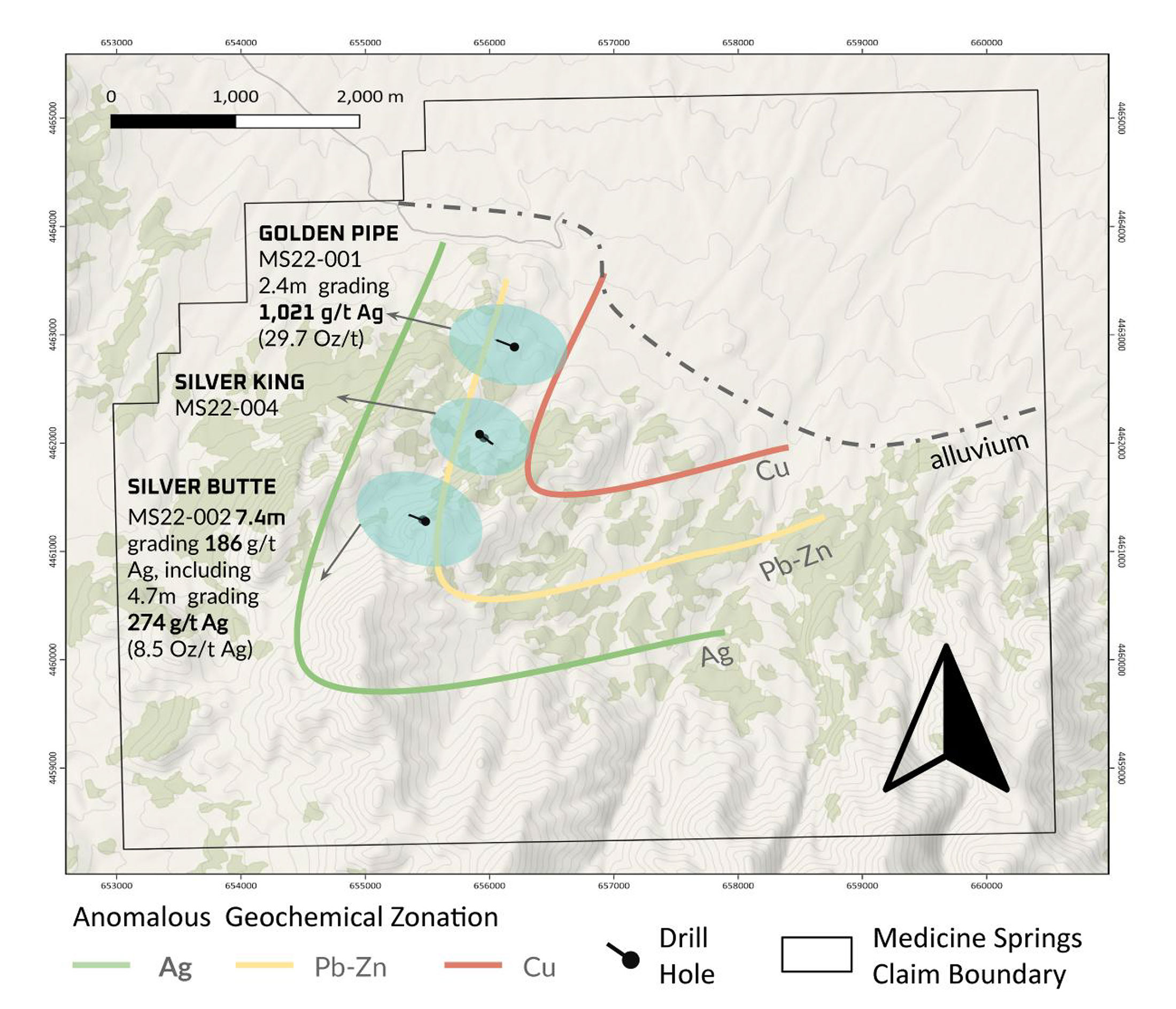
The only downside here is that drilling in Nevada is expensive. Very expensive. According to the FY2022 results, Reyna spent C$1.94M on drilling at Medicine Springs (as part of a total C$2.8M exploration budget). Considering the drill program consisted of just 1,850 meters the average cost per meter drilled was almost C$1,050. Reyna Silver plans to complete an additional 3,000 meters of drilling this year and we should expect a full-year budget of C$3-3.5M for Medicine Springs.
But you can’t make an omelette without breaking eggs, and the first pass drill program was a success. Although the company only drilled four holes, three holes were actually mineralized with for instance 2.4 meters containing 1,021 g/t silver in hole MS-22-001, and 7.4 meters containing 186 g/t silver in hole MS22-002 which was drilled almost 2 kilometers southwest of hole 1. Those initial drill results confirm the potential for scalable and high-grade mineralization, and the property currently already ticks 11 of the 13 boxes of key features associated with Carbonate Replacement Deposits. It is perfectly understandable Reyna Silver wants to follow up on these elements to further establish the Medicine Springs area as a CRD district.








Site Visit at Guigui
Reyna is now cashed up after the most recent capital raise
The financial markets are backing the company’s exploration plans as the company was able to raise C$8M in a private placement and bought deal. The company closed an initial C$4M LIFE bought deal financing in the first half of February and subsequently closed a private placement tranche for an additional C$4M at the same terms (with the sole difference being the LIFE financing was immediately freely tradeable while the C$4M private placement tranche will be subject to the traditional hold period of four months and one day (which means it will become tradeable in the final week of June).
Reyna Silver paid finders fees totaling almost C$0.5M which means the company cashed net proceeds of approximately C$7.5M (minus the legal expenses related to the two financings) and this, in combination with the existing working capital position of C$1.8M as of the end of December, puts the company on solid financial footing to drill all three projects this year.










Historically mined Mantos zones
Conclusion
2023 will be a busy year for Reyna Silver as the company plans to drill all three main projects with Batopilas being drilled first before completing a drill program at Medicine Springs. Guigui will also be drilled again but this will likely only happen in the fall which means we very likely shouldn’t expect Guigui assay results before the end of this year (depending on the effective start date of the drill program, of course).
After completing our site visit at Guigui, we feel we now have a much better understanding of the company’s methodological exploration approach as you can’t just blindly punch holes in the ground in an attempt to find the missing link to the Western Camp and Eastern Camp. The Megaws are convinced the source of both the Potosi and San Antonio mines could be found on the Reyna Silver claims.
Exploration is never easy but Reyna Silver will need to report some good results (on either of the three projects) this year as the company obviously remains at the mercy of the capital markets to raise additional funds in order to continue its exploration activities. Reyna is fully funded for the 2023 exploration programs so there is absolutely no near-term pressure on the company’s treasury.
xters in before drilling will be suspended for the Christmas period. The start of the drill program in December means we will probably see the first assay results towards the end of January. Keep in mind this is just a first pass drill program and we should have realistic expectations, but the data from the 10,000 meter drill program should tell Megaw and his team a lot about what’s hiding beneath the surface.
Disclosure: the author has a small long position in Reyna Silver. Reyna is not a sponsor of the website. We covered our airfare to Mexico, Reyna Silver covered local expenses and a domestic flight. Please read our disclaimer.
